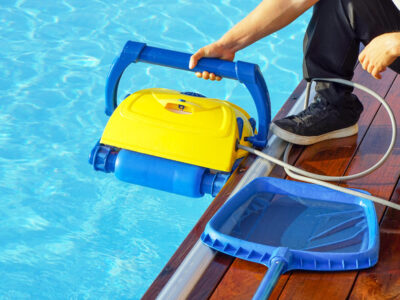Leaks are not visible to one from the outside. Most of the leaks are often inside the pipeline or plumbing, and therefore, it is quite difficult to track them. However, if the leak occurs at the pipe connector, then it makes all things worse. If it happens there, then it requires a lot of hard work to mend it properly and to make it good enough to run again.
How to Find a Leak in In-Ground Pool Piping?
This question arises in almost everyone’s mind as it is something that happens most frequently, and that is why people often want to get an answer to this question.
Well, in this article, we will discuss the methods and ways that we can use to find the leaks if they are occurring inside the plumbing.
Though it is a tedious task, we have come up with some great in-ground pool ideas and tips and tricks that will help you find out the leaks if they are there inside the plumbing.
As you know, a suction system pulls the water from the pool and then brings it back to the filter. This is the only system that helps pump the water back to the pool once it gets filtered.
The water that goes under filtration when comes out and ready to go through the jet, and inlets go through the inside plumbing of the pool. This is where most of the leakages are found. Though it is difficult to find what kind of leakage is there in the in-ground pool, we can surely find the area where the leak occurred.
For this, the first and foremost thing is to excavate the pipe. Once the pipe is excavated, only you will be able to figure out the leak that has occurred. Without excavation of the piping, it is almost impossible to predict the actual area where the leak has happened and the type of leak, whether it is too small that can be mend without trouble or if it is a big one that requires a heavy task.
Signs to Know if there is a Leak in the Plumbing.
Till now, you must have figured out that detecting a leak is not a heavy task but mending the leak is a tedious job to do. When the leak is too small, it generally does not get pointed out because it does not badly affect the plumbing or the piping system. However, if the leak is big, then you will eventually get to know about the leak in not more than two to three days.
Low Water Pressure – The first and foremost thing you will notice if there is a big leak in the inner plumbing is the water pressure. As you know, while pumping the water, the inlets push the water hard, and therefore the pressure of the water should be high in the in-ground pool, and if you get a feeling that the pressure of water is low, then it means that there is a leak inside the plumbing.
Unable to Prime – If you find that your pump is now not able to be primed, then it also indicates that there is something wrong with the valves. This can happen when the valves are closed or blocked due to a leak. So, this is a warning sign, and you should always look for it then and there because it can cause big trouble if you avoid that.
Losing Prime – Another good warning sign is that the pump is getting dried too often. This is a major issue, and this happens in many cases. This is quite unnoticeable because people are not able to recognize the warning sign. So, if this ever happens with your inlet or the piping, then you should take the necessary actions as soon as possible because if it is avoided for a long time, then it will create more trouble for you.
Air Bubbles – This is the easiest and the most prime method of finding out the leak in the pool’s plumbing. If you start getting to see bubbles everywhere in the pool while the inlet is running, it indicates a big leak in the plumbing or the piping. In this case, it mostly gets occurred at the pipe connector, but it can happen anywhere. This needs a deep dive into the issue, and only then will you be able to find out the leak.
How to Test for a Leak in In-Ground Pool Piping?
There is a tool available in the market that you can use to test any leak in the inner piping, known as Testing Rig or Testing Stick. It is a kind of stethoscope for plumbing that detects the air running inside the inlet and hence detects the leak.
Overall, detecting a leak is an easy task, but mending it is a tedious job to do, and therefore you should always hire a professional for this task. The leaks get fixed easily when they are configured in the right manner.









Comments